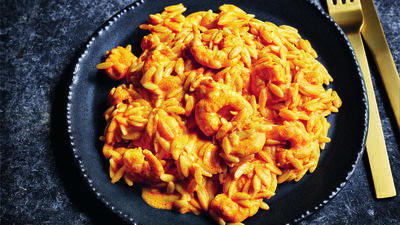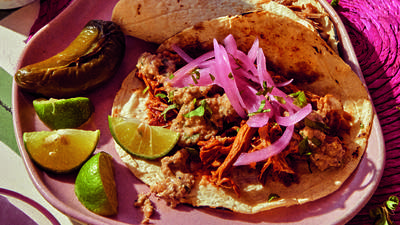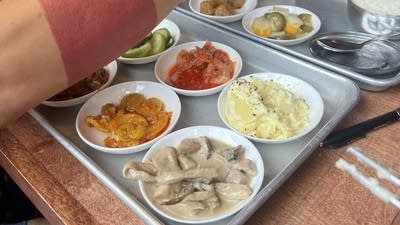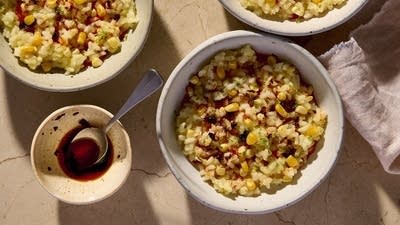From The Splendid Table: Recipes from Emilia-Romagna, the Heartland of Northern Italian Food by Lynne Rossetto Kasper (Morrow, 1992). © 1992 by Lynne Rossetto Kasper. All rights reserved.
From the table s of Ferrara's 18th-century nobility, this domed pie is still popular today. Under a sweet crust is maccheroni in a creamy sauce, studded with porcini mushrooms and a chunky rag˘.
The pie was created in 1700, when a papal delegation arrived in Ferrara with much pomp and feasting. Its dome shape, inspired by the priests' hats, was a tribute to the churchmen. It is still the traditional first course of Ferrara's weddings and holiday dinners, and Pasticcio di Maccheroni always marks Fat Tuesday and the last Sunday of Carnival before Lent. Some cooks use fresh local white truffles instead of the wild mushrooms. This particular recipe is a melding of two family versions shared by Ferrarese linguist Riccardo Rimondi.
Ingredients
Serves 10 as a first course; 6 to 8 as a main dish
Mushrooms:
2 cups (2 ounces) dried porcini mushrooms
1 1/2 cups hot water
1 tablespoon unsalted butter
1 small onion, minced
Salt and freshly ground black pepper
Béchamel:
3 cups milk
1 medium onion, sliced
1/2 teaspoon each white peppercorns and whole cloves, crushed
2 California bay laurel leaves
5 tablespoons (2 1/2 ounces) unsalted butter
5 tablespoons all-purpose unbleached flour (organic stone-ground preferred)
Salt and freshly grated white pepper to taste
Freshly grated nutmeg to taste
Pastry:
3 1/2 cups (14 ounces) all-purpose unbleached flour (organic stone-ground preferred)
1 cup (4 ounces) cake flour
1/2 cup (3 1/2 ounces) sugar
Pinch of salt
10 tablespoons (5 ounces) unsalted butter, chilled
2 eggs
2 egg yolks
Pasta, Ragù, and Cheese:
1 tablespoon unsalted butter
6 quarts salted water
1 pound dried imported penne rigate (ribbed narrow tubular maccheroni)
1 cup (4 ounces) freshly grated imported Italian Parmigiano-Reggiano cheese
1 recipe Meat Ragù with Marsala (recipe follows)
Garnish:
1 egg, beaten
Fresh lemon leaves, bay leaves, laurel leaves, or ivy
Instructions
Working Ahead: Prepare each part of the dish well ahead and then assemble shortly before baking. The mushrooms, bÈchamel and rag˘ will hold, covered, in the refrigerator up to 3 days. Although bÈchamel and mushrooms do not freeze, the rag˘ can be frozen up to 3 months. Pastry can be made 3 days ahead and refrigerated. Cook the pasta just before assembling the pie.
Making the Mushrooms: Porcini can be sandy so first swish them in a bowl of cold water. Pause for a moment, allowing particles to settle to bottom of bowl, then quickly scoop out the mushrooms with your hands. Put the mushrooms in another bowl and cover with the hot water. Soak about 30 minutes, or until softened. Lift out the mushrooms, squeezing them to release as much liquid as possible. Reserve the soaking
water. If mushroom pieces feel at all gritty, lightly rinse each piece under cold, running water. Coarsely chop. Heat the l tablespoon of butter in a small skillet over medium high heat. Add the mushrooms and small onion and sautÈ about 3 minutes. Season lightly with salt and pepper, cool, cover and refrigerate. Strain soaking liquid through a paper-towel-lined sieve and measure out the 2/3 cup needed for the rag˘.
Making BÈchamel: This old style recipe produces an especially aromatic version of bÈchamel. Flavor the milk by combining it with the onion, peppercorns, cloves, and bay leaves in a 4-quart pot. Simmer, uncovered, for 10 minutes, and remove from heat. Take another 3 to 4 quart pot to make the sauce. Melt the butter over medium low heat and stir in flour. Stir about five minutes, adjusting heat so that flour does not color. Strain milk into the pot and raise heat to medium. Whisk continuously until sauce comes to a gentle bubble. Keep whisking as the sauce bubbles quietly for 5 to 8 minutes. The bÈchamel is ready when any raw flour taste has disappeared and the sauce is thick enough to generously coat the spatula. Season to taste. If not using soon, cool and cover surface with a sheet of plastic wrap before refrigerating.
Making Pastry: In Food Processor: Combine dry ingredients in food processor. Add butter and process with on-off pulse until mixture looks like coarse meal. Add the eggs and blend in with on-off pulse until mixture starts to gather in clumps. Turn out onto a sheet of plastic wrap; gather into a ball, wrap, and chill at least 30 minutes.
By Hand: Stir together dry ingredients in a large bowl. Using only your fingertips, rub in the butter until mixture resembles coarse meal with occasional shales of flour coated butter. Hollow out a well in the flour and add the eggs. Beat the eggs with a fork to blend them. Then start tossing them with the flour/butter mixture until the dough is moistened. Do not stir or beat, and don't worry if dough looks rough. Gather it into a ball, wrap and chill at least 30 minutes.
Assembling the Pie: Preheat oven to 425°F. Have the mushrooms, rag˘ and bÈchamel at room temperature. Grease the bottom and sides of a 10-inch springform pan. Roll out one-third of the pastry to about 1/4 to 1/8 inch thick. Cut into a 13-inch circle. Fit into bottom of pan (dough will be fragile, so do not hesitate to press into pan with your hands if it breaks), forming a 1-1/2-inch border up sides. Slip into the refrigerator to chill for about 30 minutes. Then line the chilled pastry with foil, weight it with dried beans or rice, and bake 10 minutes. Remove liner, prick with fork and bake five more minutes. Cool. Remember to leave oven on. Have the mushrooms, rag˘ and bÈchamel at room temperature.
Bring the 6 quarts of water to a fierce boil. Drop in the pasta and cook, stirring frequently, until barely tender. It still has to bake inside the pie. Drain thoroughly in a colander and turn into a large bowl. Blend the bÈchamel and half the cheese into the pasta. Fold in mushrooms, but do not blend them in totally, leave clusters here and there. With bottom crust still in the springform, spread half the pasta over it. Top with half the rag˘ and sprinkle with half remaining cheese. Form a domed mound by topping the rag˘ with half the remaining pasta. Spread the rest of the rag˘ and cheese over the pasta. Then top everything with the remaining pasta. Use the back of a large spoon to gently compress the tiers into a tall dome shape. Roll out the remaining pastry into a large circle. Set springform with its filling on a few large cans. Release and slip off its sides. Then place the bottom of the springform with its Pasticcio filling on a baking sheet. Brush the outside of the pastry base with beaten egg. Lay the rolled out pastry over the mound, sealing it to the egg-covered side of the base. Trim so there's a one-inch edge. Roll that up to form a crimped rim around base of dome. This decorative rim should almost entirely cover any sign of the springform pan base. Brush the whole crust with beaten egg. Using a fluted biscuit cutter, cut out several different sized rounds and arrange in a geometric pattern over top of pie (if your dough broke while being laid over pie, pinch together breaks and cover with decoration). Make four slits near top of pie. Brush again with egg. Slip baking sheet onto middle rack of the oven. Bake 20 minutes at 425°F. Lower oven to 375° and bake 35 to 40 minutes more, or until deep golden brown. Turn off oven; leave door ajar and let pie rest 10 minutes (do not leave much longer as it will dry out). Set on large round platter and garnish with clusters of lemon leaves, fresh bay, laurel or ivy. Serve hot.
Wine Suggestions: From Emilia-Romagna pour a white Albana di Romagna Secco or a red Sangiovese di Romagna Riserva. From other parts of Italy, drink a white Tocai from Friuli, or a soft red Merlot from Friuli or the Veneto's Colli Berici.
Meat Rag˘ with Marsala
Rag˘ di Carne e Marsala
From The Splendid Table: Recipes from Emilia-Romagna, the Heartland of Northern Italian Food by Lynne Rossetto Kasper (Morrow, 1992). © 1992 by Lynne Rossetto Kasper. All rights reserved.
This rag˘ grew out of a taste memory and two old Ferrara family recipes. In test after test of trying to duplicate my favorite Domed Maccheroni Pie of Ferrara I was haunted by an elusive element, a taste I could not quite single out. Then Riccardo Rimondi shared his family's recipes and there it was. A little Marsala reduced into the meats of the pie's rag˘ sauce made the subtlest, but all-important, difference. Emerging from this rag˘ of several meats and savory liquids are flavors that constantly change on the palate. Certainly use this rag˘ in the domed pie, but savor it to the full all by itself over pasta (tagliatelle is my preference). The recipe doubles easily.
Makes enough rag˘ for 12 ounces of dried pasta
- 12 ounces turkey or chicken giblets, trimmed of tough membrane and cut into large chunks
- 8 ounces bone-in veal loin chop, boned and cut into large chunks
- 3 tablespoons unsalted butter
- 1 small to medium onion, minced
- 1/2 stalk celery, minced
- 1/2 medium carrot, minced
- 1 ounce Prosciutto di Parma, minced
- 3 ounces lean ground beef chuck
- 2 ounces prosciutto cotto or boiled ham, chopped
- 6 tablespoons dry Marsala
- 2/3 cup dry white wine
- 2/3 cup strained Porcini mushroom soaking liquid (see Note)
- 2/3 cup homemade stock or low-sodium broth (College Inn is one of our picks.)
- 1 1/2 tablespoons imported Italian tomato paste
Working Ahead: The rag˘ can be made up to 3 days ahead. Store, covered, in the refrigerator. It freezes well up to l month. Reheat the sauce gently.
Browning the Rag˘ Base: Coarsely grind the giblets and veal together in a food processor fitted with the steel blade, or grind them in a meat grinder. Heat the oil in a 12-inch heavy skillet over medium high. Drop in the minced vegetables and Prosciutto di Parma. SautÈ, stirring often with a wooden spatula, 3 minutes, or until onion begins to pick up color. Add the ground meats, including the beef or the prosciutto cotto. Turn the heat up to high, breaking up chunks and stirring to encourage even browning. A brown glaze should develop on the pan's bottom. Take care not to burn it, as the glaze contributes important flavor to the sauce. The browning takes 8 to 10 minutes.
Reducing: Add the Marsala, reduce heat to medium, and bubble slowly until all the liquid has evaporated. Keeping the heat at medium, add white wine and cook it off as you scrape up the brown glaze. This should take about 15 minutes. Reduce the mushroom liquid and tomato paste down to nothing.
Simmering: Turn the rag˘ into a 3- to 4-quart saucepan. Stir in the stock, and adjust heat so that the rag˘ bubbles very slowly. Partially cover, and cook 30 to 40 minutes, until it resembles a thick soup.
Serving: Toss with freshly cooked pasta and serve at once. Freshly grated Parmigiano-Reggiano cheese is delicious with this rag˘.
Wine: A soft, light-bodied red like a young Santa Maddelena Classico from the Trentino-Alto Adige region, or a young Valpolicella Classico of the Veneto.
Cook's Notes: Porcini Mushroom Liquid: Whenever the mushroom's liquid is not called for in a recipe, strain it and freeze it for dishes like this one. If unavailable, substitute another 2/3 cup of stock.
Before you go...
Each week, The Splendid Table brings you stories that expand your world view, inspire you to try something new, and show how food connects us all. We rely on your generous support. For as little as $5 a month, you can have a lasting impact on The Splendid Table. And, when you donate, you’ll join a community of like-minded individuals who love good food, good conversation, and kitchen companionship. Show your love for The Splendid Table with a gift today.
Thank you for your support.
Donate today for as little as $5.00 a month. Your gift only takes a few minutes and has a lasting impact on The Splendid Table and you'll be welcomed into The Splendid Table Co-op.



